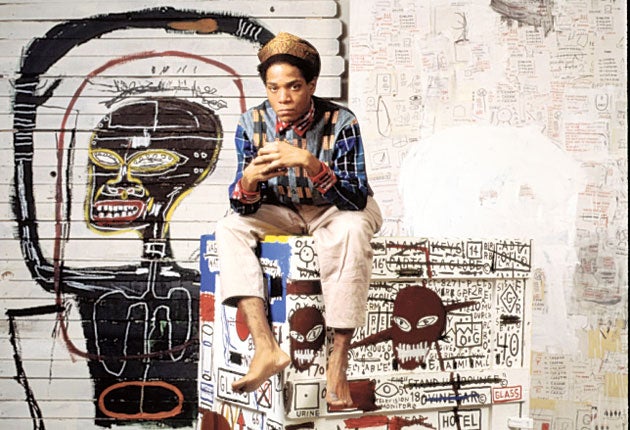FBI investigating Orlando museum’s 25 Basquiat paintings as fake, report says
A brand expert from FedEx challenged the claim of when the cardboard paintings were made because of a font not used before 1994, when they were reported to be made in 1982

The authenticity of more than two dozen works of art purported to have been created by Jean-Michel Basquiat are being investigated by the Federal Bureau of Investigation’s Art Crime Team, the New York Times reported.
In a federal subpoena directed to the Orlando Museum of Art, the institution that houses the 25 pieces of supposedly original Basquiat’s, the agency demanded that “any and all” pieces of communication between staff members and the owners of the pieces of art, “purported to be by artist Jean-Michel Basquiat”, be turned over to them.
As the story goes, the artwork was allegedly first drawn up on several pieces of cardboard in 1982, while the then-22-year-old pioneering street artist was living in a studio beneath the home of Larry Gagosian, an art dealer who Basquiat was preparing fresh canvases for a new show at his gallery.
This artwork, according to the owners and the museum’s account, was then sold to now deceased screenwriter Thad Mumford for $5,000, who then transferred the items to a Los Angeles storage unit, where they were left untouched and unseen for nearly 30 years.
The contents were later auctioned off in 2012, and the artworks were handed over to their new owners: William Force, an antiques dealer, and Lee Mangin, a retired salesperson, at a price tag of $15,000.
Aaron De Groft, the chief executive of the museum, maintains the artworks authenticity, telling The Times back in February: “I’ve absolutely no doubt these are Basquiats.”
In a statement from the museum’s communications team, a spokesperson told The Independent that OMA has “complied with a request for information” from the FBI.
“The Museum has never been led to believe it was or is the subject of any investigation and has never had any FBI activity on-site. We see our involvement purely as a fact witness. As we close the Heroes and Monsters exhibition in a few weeks, we will continue to cooperate should there ever be any future requests,” said the spokesperson.
Outside of his own expert eye, which is a PhD trained art historian from Florida State University, the OMA executive also has receipts. Specifically, a piece of poetry.
In 1982, Mumford penned a poem acknowledging Basquiat’s creations and a meeting that took place between the two blooming artists.
In one line, it refers to “25 paintings bringing riches,” while another line references the two men’s “outsider” status in the entertainment and art world: “No longer outsiders, Industry insiders golden crowns receiving.”
The poem, sealed with “JMB” initials, was, according to Mr Mangin, handed over to him by Mumford in 2012 after he took ownership of the 25 artworks from the storage unit.
The screenwriter, who died in September 2018, told the new owner over lunch about how he’d purchased the cardboard artworks from his friend as an investment in 1982, according to Mr Mangin.
The New York Times initially reported on the scepticism that arose when the largely unseen artworks were first unveiled in the OMA’s “Heroes & Monsters: Jean-Michel Basquiat” exhibition in February, with an unlikely expert arising as the central point of contention in verifying the artwork’s authenticity: a FedEx worker.
Lindon Leader, an independent brand expert that The Times consulted back in February, surveilled the cardboard that Basquiat had reportedly drawn up his paintings on and found that if you flipped over the back, there was a damning line of company imprint, which read in clear black ink: “Align top of FedEx Shipping Label here.”
The issue, Mr Leader told the newspaper, wasn’t the words, but the font. According to his eye, the font used on the cardboard where the 25 Basquiats in question are drawn was a text that wasn’t used by Federal Express company before 1994, which is more than 12 years after their purported creation and, more centrally, six years after the artist died of a drug overdose.
“It appears to be set in the Univers 67 Bold Condensed,” the brand expert regaled to The Times about the box’s 1994 font, an area of expertise that he’s intimately familiar with having been personally tasked with redesigning the moving company’s logo in that same year.
The work, which ranges from a printer paper size work of the artist’s iconic crowns to a disembodied head plastered on a piece of cardboard the height of a small person, is valued to be worth $100m, according to Putnam Fine Art and Antique Appraisals.
Just last year, an unsealed complaint filed by the Southern District Court of New York revealed that the FBI had accused a 49-year-old man of trying to sell a fake Basquiat, which he called Glory Boys Kingdom, for a price tag of $6m.
Though the specific target of the FBI’s investigation into the Basquiat’s at the Florida museum remains unknown to the public, knowingly selling fake art is a federal crime and can carry serious jail time if caught and convicted.
In February 2017, a Michigan con artist, Eric Ian Hornak Spoutz, was sentenced in New York to 41 months in prison after being found out to have defrauded art collectors of $1.45m. He was also ordered to pay out more than $154,000 in restitution.
The Independent reached out to the OMA for comment but did not receive a response immediately.



